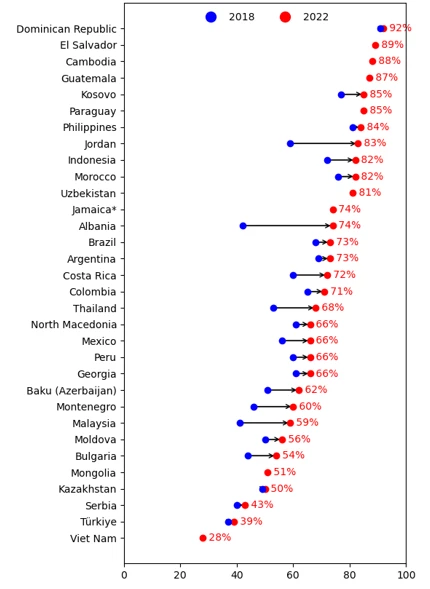 In countries that participated in PISA in 2018 and 2022, more students fell behind in 2022, almost certainly as a consequence of the pandemic. Copyright: Ed Wray/World Bank
In countries that participated in PISA in 2018 and 2022, more students fell behind in 2022, almost certainly as a consequence of the pandemic. Copyright: Ed Wray/World Bank
Last month the world received a wake-up call as to the depth of the learning crisis facing developing countries. The newly published results of the 2022 Program for International Student Assessment (PISA) showed that in the wake of the pandemic in many countries, most children are not learning even the basics.
PISA is administered in the bulk of high-income countries as well as an increasing number of middle-income countries. We focus here on the results for middle-income countries. No low-income countries—which are principally in sub-Saharan Africa—are part of PISA.
The figure below compares the share of students below basic proficiency in math at age 15 in 2022 and 2018. Shockingly, in all but four middle-income countries, the majority fall below this minimum standard. In all of these countries that participated in PISA in both years, more students fell behind in 2022, almost certainly as a consequence of the pandemic.
Share of students below basic proficiency in math
You may wonder what “basic proficiency” means. This is Level 2, which PISA considers the baseline level to participate fully in society. Here is an example of a Level 2 math problem from the 2022 PISA:
Alex drew the following pattern of red and blue triangles. The first four rows of the pattern are shown below. If Alex were to extend the pattern to a fifth row, what would be the percentage of blue triangles in all five rows of the pattern?
40.0%
50.0%
60.0%
66.7%

The PISA results are likely just the tip of the iceberg
We know from country-specific assessments from the US and elsewhere that children younger than those tested in PISA took the largest hits to their learning during the pandemic. We worry that the next PISA in 2025—which will test children who were age 10 at the start of the pandemic—will show further learning declines.
However, it's not too late to address this crisis. Governments, teachers, and parents can help children recover from pandemic learning losses. Effective approaches include increasing instructional time, tailoring teaching to students' current levels, and focusing on foundational skills like math, reading, and writing.
These were emphasized in the World Bank’s study Collapse & Recovery: How COVID-19 Eroded Human Capital and What to Do About It, and are part of the World Bank’s global education strategy.
*The correct answer is 40%*
To receive weekly articles, sign-up here





Join the Conversation